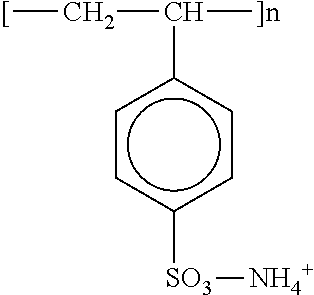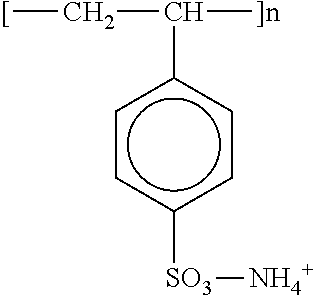Fine-processing agent and fine-processing method
a technology of fine-processing agent and fine-processing method, which is applied in the direction of basic electric elements, electrical apparatus, chemistry apparatus and processes, etc., can solve the problems of high foaming ability, difficult to achieve desired shape, and unsuitable for semiconductor device manufacturing processes, etc., and achieve low etching controllability
- Summary
- Abstract
- Description
- Claims
- Application Information
AI Technical Summary
Benefits of technology
Problems solved by technology
Method used
Image
Examples
example 1
[0053]A solution of a mixture of 7.0 parts by weight of hydrogen fluoride (high-purity grade for semiconductor applications, 50% by weight in concentration, manufactured by Stella Chemifa Corporation), 50.0 parts by weight of ammonium fluoride (high-purity grade for semiconductor applications, 40% by weight in concentration, manufactured by Stella Chemifa Corporation), and 40.5 parts by weight of ultrapure water was prepared, and 2.5 parts by weight of poly(ammonium acrylate) (6,000 in weight average molecular weight, 40% by weight in concentration) as a water-soluble polymer was added to the solution. After mixing and stirring, the liquid mixture was adjusted to a temperature of 25° C. and allowed to stand for 3 hours. Thus, an etchant (a fine processing agent) was prepared which contained 3.5% by weight of hydrogen fluoride, 20.0% by weight of ammonium fluoride, and 1% by weight of poly(ammonium acrylate).
[0054]Subsequently, etch rates were measured for a TEOS film, as a silicon o...
examples 2 to 10
[0055]In Examples 2 to 10, etchants were prepared as in Example 1, except that the contents of hydrogen fluoride and ammonium fluoride and the type and content of the water-soluble polymer were changed as shown in Table 1. Using the etchant obtained in each example, etch rates for a TEOS film and a silicon nitride film, and etch rate selectivity (silicon oxide film / silicon nitride film) were also evaluated. The results are shown in Table 2 below.
example 11
[0060]A solution of a mixture of 20.0 parts by weight of hydrogen fluoride (high-purity grade for semiconductor applications, 50% by weight in concentration, manufactured by Stella Chemifa Corporation), 27.8 parts by weight of hydrochloric acid (electronic industry grade, 36% by weight in concentration, manufactured by HAYASHI PURE CHEMICAL IND., LTD.), and 51.2 parts by weight of ultrapure water was prepared, and 1.0 part by weight of polyacrylamide (10,000 in weight average molecular weight, 50% by weight in concentration) as a water-soluble polymer was added to the solution. After mixing and stirring, the liquid mixture was adjusted to a temperature of 25° C. and allowed to stand for 3 hours. Thus, an etchant (a fine processing agent) was prepared which contained 10% by weight of hydrogen fluoride, 10% by weight of hydrochloric acid, and 0.5% by weight of polyacrylamide.
[0061]Subsequently, etch rates were measured for a BPSG film, as a silicon oxide film, and a silicon nitride fi...
PUM
| Property | Measurement | Unit |
|---|---|---|
| liquid temperature | aaaaa | aaaaa |
| concentration | aaaaa | aaaaa |
| temperature | aaaaa | aaaaa |
Abstract
Description
Claims
Application Information
 Login to View More
Login to View More - R&D
- Intellectual Property
- Life Sciences
- Materials
- Tech Scout
- Unparalleled Data Quality
- Higher Quality Content
- 60% Fewer Hallucinations
Browse by: Latest US Patents, China's latest patents, Technical Efficacy Thesaurus, Application Domain, Technology Topic, Popular Technical Reports.
© 2025 PatSnap. All rights reserved.Legal|Privacy policy|Modern Slavery Act Transparency Statement|Sitemap|About US| Contact US: help@patsnap.com


